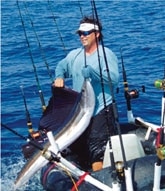
Rubber Match
Tournament fishermen leave the boats at the dock to chase sails from inner tubes.
By Colin Kearns
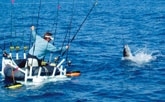
| |Totally Pumped: Rosher (left and above) tagged and released seven sailfish. Photos courtesy of “The Bite”| For the angler who thinks a decked-out boat is all that’s keeping him from fishing like a pro, think again. In May, ten top fishermen in Florida competed in a sailfish tournament with one major twist: instead of boats, they took to the sea in non-motorized tractor-tire inner tubes.
Welcome to the first ever Miami Raft Invitational Tournament.
“We wanted to do something different,” said Captain Matt Tambor, host of the fishing show, “The Bite,” on Florida’s SunSport TV that taped the event for an episode that will air this summer. “An afternoon of jackass fishing was just what these guys needed to get away from the stress of regular tournaments.”

| |The bite stalled for Vernon, who mounted his son’s go-kart frame onto his inner tube. Photo: Allison Liederman| The fishermen had two months to trick-out their tubes into fishable floats. Captain Harry Vernon, Jr., arrived with his son’s go-kart frame mounted on his inner tube. “I had the best-looking raft out there,” said Vernon, who admitted that form didn’t meet function. He went home skunked. “The frame worked, but it handles better on the racetrack.”
Captain Ray Rosher didn’t leave anything to chance with his raft, rigging it with 16 rod holders. He won first place with three sailfish tags and releases. After lines-out, Rosher stamped his win by floating into a quadruple-header, landing all four without any help.
Rosher, who donated his $1,000 prize to the Youth Fishing Founda-tion, said landing seven sails on a makeshift raft was a cheap reality check: “One thing’s for sure, I’ve spent too much money on boats.”
WORLD-RECORD REDFISH?
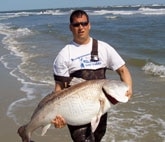
| |Daniel Monette hauled in this 53-inch redfish at Ocracoke Beach, North Carolina. Photo: Daniel Monette| Daniel Monette of Louisburg, North Carolina, just might have caught a world-record-breaking redfish this past April, but he’ll never know for sure: he released the fish before weighing it on a certified scale because North Carolina regulations prohibit fishermen from keeping redfish 27 inches or longer. Fishing with fresh mullet on 20-pound line at Ocracoke Beach, Monette beached a bull measuring 53 inches long with a 38-inch girth. Based on the standard length-girth formula, Monette’s redfish was estimated to weigh 95.6 pounds more than one pound heavier than the current world record of 94.2 pounds. “I was a little disappointed to let it go without knowing if I broke the record,” he says. “But I wouldn’t ever want to kill a fish like that.”
Fly Fisherman sets new sailfish Release record
| Sails | Day by Day |
| Day One | 7 releases |
| Day Two | 10 |
| Day Three | 7 |
| Day Four | 2 |
| Day Five | 4 |
| Day Six | 5 |
| Day Seven | 3 |

| |Angler Joe Zimmer caught 38 sailfish in seven days. Photo: scottkerrigan.com| Joe Zimmer of Berlin, Maryland, broke the one-day record for Atlantic sailfish on the fly earlier this year. Fishing out of Isla Mujeres, Mexico, aboard the Prime Time, Zimmer was led by Captain Butch Cox to ten Atlantic sailfish on 20-pound tippet and abided by IGFA fly-fishing rules for billfish. Along with the ten-fish day, the solid action continued throughout the week with Zimmer releasing 28 fish in six days, making for a total of 38 Atlantic sailfish on the fly in seven days. Karl Anderson
Feds Drop Longline Research
The National Marine Fisheries Service (NMFS) has decided not to issue Exempted Fishing Permits (EFP) to conduct scientific research using pelagic longline gear in waters along the Gulf of Mexico, the Florida East Coast, the South and Mid-Atlantic Bights and the Northeast Coastal Atlantic. All of those areas are currently closed to longlining. NMFS proposed the EFPs in March but backed down two months later after consistent pressure and protest from the Recreational Fishing Alliance. NMFS dropped the research proposal to further assess the environmental impacts associated with fishing in existing areas closed to pelagic longlines. For more information, visit www.joinrfa.org.
Fast Traveler
Tagging Study Yields Break-Through Dolphin Catch
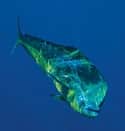
| |Photo: toshbrown.com| Researchers involved with the South Carolina Dolphin Tagging Study have found their “golden fish.” In April, a fisherman on a charter boat out of Majahual, Mexico, landed the same dolphin that was caught and tagged off Charleston the previous May.
The recapture of the tagged dolphin is the first documentation of the species moving from the East Coast of the United States to Mexico’s Caribbean coast. Researchers were able to determine that the dolphin, which had a 24-inch fork length and weighed 41¿¿2 pounds when it was first caught in May 2004, grew 17 inches and gained 231¿¿2 pounds in the less than 11 months between the two catches.
For more information, visit www.dolphintagging.homestead.com.
Regulation Watch
Beach Closures for the Birds
Earlier this spring, the National Parks Service Outer Banks (North Carolina) Group proposed to close certain beaches to “all human activity” so that piping plovers can nest without disturbance. But for the anglers who look forward to fishing these hot spots each season, the proposed closures will prevent surf-fishing for the world-class red drum that feed there. Proposed under the Endangered Species Act, the closures could shut down the majority of beaches at Oregon Inlet, Hatteras Inlet and Cape Point — all of which are popular fishing spots — to any recreational use until as late as August 31. For more information, visit www.nps.gov/caha/capehatteras.htm.
Ship Ballast Gets a Guilty Verdict
Coastal environmental groups in California won a legal victory earlier in the spring when a federal judge ruled that the Environmental Protection Agency (EPA) must regulate ballast water from ships that enter U.S. waters. Discharged ship ballast has been blamed for the introduction of harmful non-native species to San Francisco Bay and other waters. For more information, visit www.savesfbay.org.
New England Fish stocks rising?
Overall, salt water fish stocks in the Northeast are in the black, according to the National Marine Fisheries Service (NMFS). Earlier this year the agency released the results of its Fall 2003 and Spring 2004 bottom-trawl surveys of commercially and recreationally important groundfish stocks off the Northeast coast. The collected data indicates that the combined population of every species sampled for the study continued its steady rise from the historic lows recorded in the early 1990s. Cod, scup, pollock, weakfish and black sea bass all dropped somewhat from their showings of the last few years, but all five species were nonetheless in better shape than they had been a decade earlier. The NMFS survey evaluates the populations of important salt water species twice annually. For more information, visit www.nefsc.noaa.gov/esb/survey.htm.
Devils in the Deep
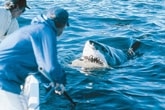
|
|Biologists trolled seal dummies behind a 17-foot Boston Whaler to attract great whites. Photo: Peter Pyle|
Take an up-close and personal look at great whites.
Susan Casey’s new book, The Devil’s Teeth: A True Story of Survival and Obsession Among America’s Great White Sharks (Henry Holt and Company; $25), brings us face to face, again and again, with a fearsome and much-maligned predator of the deep, the great white shark. For reasons that aren’t entirely clear, each year the waters surrounding the Farallon Islands, an obscure and forbidding archipelago 27 miles west of San Francisco, teem with countless 15- to 20-foot-long great white sharks for three months. Casey spends 33 days — speeding to the scenes of bloody seal attacks and trolling seal dummies off a 17-foot Boston Whaler — with two surfer-biologists in an attempt to solve the basic mysteries about these fish that are said to have hunted the oceans since before there were trees: How long do they live? How big can they get? When, where and how often do they reproduce?

|
|Photo: John Keller/Cliff Gardiner|
Devil’s Teeth blends natural history with seductive adventure and the incredible. Casey tells her story with an obsession that will be familiar to any angler who targets a favorite species. And for those who have wondered what might happen if you abandon yourself to the chase, the ending of the book will offer a hint.
— Catherine DiBenedetto
Sea Smog
Scientists concerned about the effects of rising ocean noise levels on marine life
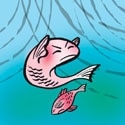
| |Illustration: Jorge Colombo| The ocean is getting louder, and it might be affecting the way fish behave. A report published by the National Academy of Sciences stated that the shipping weight of the world fleet has increased by almost 500-million tons since 1948, causing background noise in the ocean to rise more than 15 decibels. Since hearing is the primary sense for many marine species, some scientists are worried about the effects the noise is having on them, comparing it to an “acoustic smog” that disrupts basic behavioral activities, such as feeding and communication.
Big Bass Bucks
If given gamefish status, the striped bass would create more jobs and generate more revenue, according to a new study.
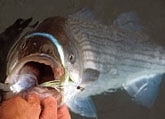
| |The “Southwick Study” found the striped bass to be a sound investment. Photo: Jim Levison| In April, Sripers Forever Inc. published the “The Economics of Recreational and Commercial Striped Bass Fishing,” (a.k.a. “The Southwick Study”) which assesses the economics of striper fishing from Maine to North Carolina. Stripers Forever (www.stripersforever.org) is a non-profit organization that seeks to make striped bass a gamefish at the state level and to eliminate the commercial fishery. Below are the key findings. So, should the striper become a gamefish? Check out the numbers and decide for yourself.
Striped Bass By The Numbers
3,018,361: Anglers from Maine to North Carolina who fished for striped bass in 2003. 11,133,276: Striped bass fishing trips made from Maine to North Carolina in 2003. $2,410,000,000: Amount in direct retail sales generated from the striped bass recreational fishery in 2003; 55.9 times greater than the commercial fishery. 63,278: “Full-time equivalent” jobs provided by the striped bass recreational fishery in 2003; 12.6 times greater than the commercial fishery. $412,765,765: Combined amount of state and income taxes and federal income taxes paid by the striped bass recreational fishery in 2003. $1,790,000: Estimated dollar increase in direct retail sales if the striper was made a gamefish; a 24-percent increase. 14,400: Estimated job increase if the striper was made a gamefish; also a 24-percent increase. 11,500,000: Pounds of hybrid striped bass produced through aquaculture in 2003. 7,100,000: Pounds of wild striped bass harvested in 2003. $2.75: Average price per pound for hybrid striped bass. $2.78: Average price per pound for wild striped bass.
Short Strikes
The 2005 Los Sue-os Signature Billfish Series presented by Cabo Yachts ended in March with 32 teams releasing 895 billfish.The fish-to-boat ratio for the event of 27.92 (or 9.32 billfish per boat per day) is one of the highest such results in tournament history — www.lstournaments.com
New York Assemblyman Robert Sweeney (D-11th District) introduced the Freedom to Fish Act. The bill would prohibit fishing closures if less restrictive measures are adequate to restore fisheries and requires periodic review of any closures — www.nysf.org
As a favor to customers, Grady-White Boats has placed every product catalog since its first year of business as well as the past five years of Anchorline, the company newsletter, on its website — www.gradywhite.com
Striped bass stomach contents collected by the Virginia Institute of Marine Science indicate that menhaden account for ten percent of the diet of striped bass — much less than the presumed 50 percent — www.vims.edu
Florida Has a New Way to Measure Up
The Florida Fish & Wildlife conservation Commission has proposed rule changes to clarify and standardize how anglers measure salt water finfish. Currently, size limits of marine species are described in either fork length or total length. Species such as Spanish mackerel and cobia are measured by fork length “from the tip of the snout to the rear center of the tail.” However, the interpretation is not quite as clear on fish with non-forked tails like red drum or snook. The proposed rule changes call for measuring these fish with their mouths closed and tails compressed to standardize enforcement. For more information, visit www.myfwc.com.
A Shark Tale
A crew of Florida fishermen snatch a meal from a mako and capture the fish story on video.
By Colin Kearns
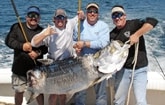
| |

TARPON, HALF-OFF: (top) The Snapper Trapper crew poses after their tarpon heist. (left) Footage of the mako with a mouthful. Photos courtesy of Paul Redman| At a Pensacola Beach cobia tournament, Captain Paul Redman and the Snapper Trapper crew spotted what looked like a ray or even a whale. A closer look, however, revealed two big surprises.
“Oh man, that’s a giant mako!” Redman shouted. What no one realized at first, though, was that the 14-foot mako had the carcass of a 200-plus-pound tarpon clenched in its jaws just like a dog with a bone.
The crew forgot about the cobia tournament and went after the mako, but first they had to steal its lunch. Now, if the Snapper Trapper crew’s fish story already sounds like just that, a “fish story,” they can back it up: They have it all on video.
“We brought the camera because we thought we might get on the local TV show, but we end up going on ¿¿Fox News Live,'” Redman said. “We never thought it’d get this big.”
The homemade flick and its profanity-laced narration summarize the 45-minute tarpon theft. To view the video, check out www.snappertrapper.com. Crewmember Jeremy Cox finally gaffed the tarpon, and three of them hoisted the carcass onboard.
Cox cast a chunk of the tarpon to the shark, and the fight was on. The battle lasted more than an hour before the mako broke the line. Still, even after losing the monster, the crew aboard Snapper Trapper took the loss in good stride.
“I was just stoked we had it on video,” Redman said. “If we didn’t it would’ve been another fish story.”
SWS Publisher Named to Angler Group Board
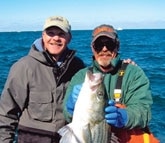
|John Young (left) after a nice catch. Photo courtesy of John Young| Time4 Media Marine Group president and Salt Water Sportsman publisher John Young was recently elected to the board of the Recreational Fishing Alliance (RFA). “He understands the importance of being engaged in marine fisheries issues,” RFA Chairman Bob Healey said.
Young, who fishes off Long Island, New York, from a 25-foot center console, said of the organization, “The RFA has demonstrated that good things happen when salt water anglers and businesses in the industry get involved in marine conservation issues.”









